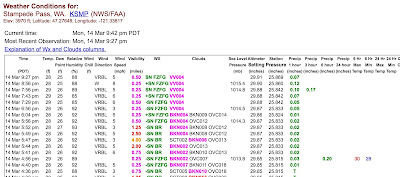Stampede Pass is probably the most valuable of all of the National Weather Service first-order ASOS sites. No Weather Service site is more isolated, miles from any paved road. Stampede not only has the typical surface observations, but also possesses a laser ceilometer that describes the height of the cloud base above (which is very useful for pilots flying across the mountains).
In addition, Stampede Pass has a horizontal visibility sensor, a freezing rain sensor, and precipitation-type identifier. No other location near the Cascade crest has such a wide range of observing capabilities.
Let me show you a sample of observations from Stampede on Monday night...
Stampede Pass is also very valuable for climate studies, since there is no urbanization anywhere nearby. Here is the plot of the surface temperatures over the past 20 years there. I will let you decide if there is any global warming signal.
We should all be thankful for the substantial efforts of the National Weather Service in getting this critical observing location back online. The key problem was communication, with the repeated loss and degradation of the telephone line to the site. Fortunately, there was a good cellular signal and that allowed the use of cell modem, AFTER they figured how to interface an ancient 9600 baud modem to a modern communication system. Clearly, the National Weather Service needs to invest in updating the 30-year old communication hardware found in their primary observing system around the nation.
Stampede Pass is also very valuable for climate studies, since there is no urbanization anywhere nearby. Here is the plot of the surface temperatures over the past 20 years there. I will let you decide if there is any global warming signal.
We should all be thankful for the substantial efforts of the National Weather Service in getting this critical observing location back online. The key problem was communication, with the repeated loss and degradation of the telephone line to the site. Fortunately, there was a good cellular signal and that allowed the use of cell modem, AFTER they figured how to interface an ancient 9600 baud modem to a modern communication system. Clearly, the National Weather Service needs to invest in updating the 30-year old communication hardware found in their primary observing system around the nation.







Stampede Pass is only a few miles from the freeway as the crow flies!
ReplyDeleteThrilled to see SMP back up and running. Don' forget, this is also a valued forecast tool for the east side of the Cascades, especially fruit frost forecasts and east slope wind events.
ReplyDeletePraise Be! Thanks to Cliff for shining the light and keeping the "heat" on the importance of the ASOS starting November 5, 2012. The Blog is mightier than the sword! There is a fairly strong correlation between Cascade air crashes (all fatal) and the availability of this weather station. It is an incredibly important tool for flight planning done properly. Thanks also to the NWS for sticking with this to get the job done right!
ReplyDelete...and more good news: Lake Shasta is at 106% of its historical average for the date. After, a dry February, I am impressed.
ReplyDeleteI gather they still need to replace the antique modem; that this just a software fix. Or is the modem retired forever?
ReplyDeleteGreat news! However, the ASOS phone number doesn't seem to be working, yet?...just continuous ringing. (360) 886-2758
ReplyDeleteThat's why it's called "global" and not "Stampede Pass" warming.
ReplyDeleteA bit of a red herring, trying to tease out a <1% change in the average on the scale of the plot.
ReplyDeleteHeaven's sake, Cliff, you think you could eyeball whether the average value increases by a fraction of a degree across that graph? I'd be happy to set up a little multiple-choice test if you'd like to try.
ReplyDeleteI submit that is rather difficult for the eye to pick out a slight temperature trend in the plot. I checked a global warming temperature plot in it looks like there has been about a 0.7 F rise over the 20 year time frame of the plot. Thats pretty tiny compared the large seasonal variations and the even larger scale of the axis. I do know that alot of ice has disappeared in the Cascades over the last 20 years and it didn't disappear because its getting colder.
ReplyDeleteWe need to look at more than 20 years to see the global warming component...
ReplyDeleteThis is great news! I'll admit to being a tad bit bummed at not getting a chance to hack on a solution here, but the joy of having an important data source back online more than makes up for it.
ReplyDeleteGlad to hear it’s still working. I was one of the people who installed that WeatherStation in the early 1990s. This site was one of my favorites. I thought it would be nice to have a private plane takeoff and land and perhaps live here.
ReplyDelete